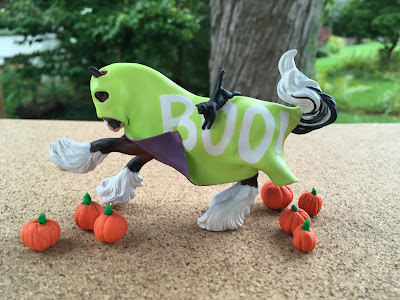Most of my custom mini work is realistic with an occasional touch of whimsy with a cat or a bow, a rolling horse, or a misbehaving pony—so I finally tried my hand at some Halloween decorator customs.
 |
| Boo with his cat Binx, and Jackie O. |
The idea began with tiny gaming sculptures that wear capes and cloaks. Would there be a way to have "fabric" sculpted on a model horse?
So... there is!
I used Milliput in Fine White. This is a two-part epoxy similar to Aves Studio White or MagicSculpt White. I found it at Michael's and also at Great Lakes Hobby & Toy here in the Detroit area.
I rolled the epoxy out like pie dough in between two pieces of sandwich bag plastic, using water to keep it from sticking too much.
 |
| Sabrina and Silk |
These sheets of epoxy became my models' sheets—their spooky Halloween costumes painted purple, black, and green with contrasting colors underneath. The sheets are supported and connected to the models on the underside with more Milliput.
 |
| Sabrina's spider |
 |
| Boo and Binx |
 |
| Moonlight |
 |
| Glow in the dark paint is clear. Paint a color for the base layer. |
For Moonlight, I used glow-in-the-dark paint over a pale yellow color for the moon. It took 20 or so coats to get it to glow. I sprayed matte sealer between layers.
 |
| Jackie O. |
For the trick-or-treat pumpkins, I used oven-baked clay in orange with a piece of wire poked through them to form the handle.
 |
| Some of the unique supplies |
Comments
Post a Comment